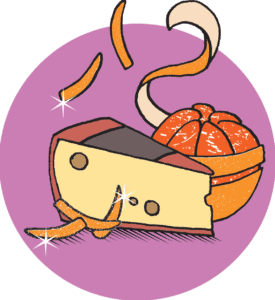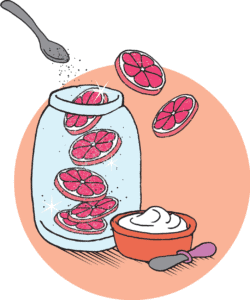
There’s something nostalgic about candied fruit, at least for me. Maybe it’s the association between sugar plums and Christmastime, or the fact that I’d always find a bag of those gummy raspberries in my stocking, the ones covered in tiny candy dots. As a little kid, I was fascinated by the idea of turning fruit or flowers into candy. “You mean to tell me,” I remember thinking when I discovered candied orange peel, “you can take nature’s candy, and…make it better? Sign me up.” I dreamt of sugared violet petals alongside the dancing plums.
As with so many modern delicacies, fruit was initially candied, or crystallized, as a means of preservation. What we think of today as a dainty cake topper fit for a princess was invented by ancient Arab peoples, who ceremonially served candied roses and fruits at banquets. It’s fitting that the invention of cheese is also attributed to the Arabs—at least, that’s how the story goes. The process of sugaring fruit is quite simple: The flesh, peel, or flower is boiled in a syrup of equal parts water and sugar (or other natural sweetener, like honey), then cooled or dried, and sometimes rolled in additional sugar before serving. Regional methods vary widely, and of course some fruits and flowers require gentler treatment than others. But the result is, as young me concluded in her candy-fueled Yuletide reveries, an improvement on perfection.
On a sugar-coated globe trot, you’d discover offerings that hail from all over the map and serve different purposes. Candied citrus peel is sometimes called succade, a term and tradition that originated with the Jewish harvest festival Sukkot. In Mexico, calabaza en tacha (candied pumpkin) is served on Día de los Muertos. And as mentioned above, before they became a Victorian treat, you’d be hard-pressed to find a Middle Eastern celebration that wasn’t sweetened by candied rose petals.
Anyone can dip a strawberry in chocolate, but it takes patience and a discerning eye to candy fruit. Lest you go the Portlandia “we can pickle that!” route and start sugaring everything within reach, there are some basic guidelines to follow on your first foray into DIY candied fruit. First of all, it’s a good idea for beginners to steer away from delicate candidates like flower petals and citrus pulp. The heartier the better to start! Flavor-wise, sourness is a good marker of success: the tangier the fruit inits original form, the more pleasing the sugar-coated result will be (think citrus peels and tart cherries). Spice is also a great flavor foil, hence the popularity (and purported health benefits) of crystallized ginger root.
And don’t shy away from unconventional flavor pairings, whether in homemade pursuits or prepared confections—I’m talking the beloved, but perplexing, Italian tradition of combining chopped fruit and mustard oil with a sweet syrup to make mostarda. If added sugar isn’t your bag, pickled fruit is an option, though a potentially divisive one for your holiday guests. Lemons preserved in brine are used as a condiment in Indian cuisine, but few except the most hard-core turophiles might serve them on a cheese plate. But don’t let a little salt stop you! Whatever your pleasure, the accompanying preserved fruit pairings are sure to sweeten the deal.
1. CRYSTALLIZED GINGER + LINCOLNSHIRE POACHER
I might get clapped in irons if a Brit heard me say it, but there’s a touch of tiki about Lincolnshire Poacher. What seems at first like a brothy, savory cheddar gives way to hints of something like piña colada. As the sleeper ingredient in many Polynesian-inspired cocktails, ginger suits this clothbound giant. Both items here possess a pleasingly toothsome texture, the dry crumble of the cheese met head-on by the sugary heat of the ginger.

2. BALSAMIC GRAPES + BELGIOIOSO MOZZARELLA
Vinegar-soaked grapes were a new one for me when someone popped one in the bottom of my cocktail in place of a maraschino cherry. Talk about sophisticated! Grapes roasted with balsamic vinegar are a popular salad topping, but heating the vinegar with herbs (try rosemary), pouring over whole grapes in a jar, and leaving them to pickle for an hour, makes for a juicier result. No need to go bold with the cheese here—anything fresh and milky like mozzarella will marry perfectly with the tangy grapes. If you’re looking for something a tad firmer and saltier, swap the mozzarella out for shavings of ricotta salata.

3. CANDIED ORANGE PEEL + CHALLERHOCKER
I would eat this cheese with just about anything pickled or preserved, but it becomes almost dessert-like when paired with something sweet. Both candied orange peel and grass-fed cow’s milk Alpine cheese share a rich, almost astringent note, like that of the darkest amber honey. Pro tip for your next wine-and-cheese night: Challerhocker makes a fine fondue ingredient, and candied orange peels are ideally shaped for dipping.

4. STONE FRUIT MOSTARDA + MANCHEGO DOP
Mostarda is one of those choose-your-own adventure condiments, but it typically consists of three elements: fruit, sugar, and mustard. The form the mustard takes can vary (seeds, oil, powder), and some add wine, spices, and even meat (why not!) to the mix. A stone fruit-based mostarda is pretty friendly to most palates, especially if the participating fruits are at peak ripeness. Pair a cherry- or apricot-based offering with a bright, salty sheep’s milk cheese like Manchego or Iberico.

5. SUGAR-PRESERVED GRAPEFRUIT + VERMONT CREAMERY CLASSIC GOAT CHEESE
Preserving citrus fruits in sugar is a great solution for that bag of lemons you had to buy when you only needed one. Or that grapefruit that sits untouched after a wishful-thinking purchase. Slice your fruit into medallions, then pack in an airtight glass jar between layers of sugar and a sprinkle of salt. Leave the jar to its own devices in a cool, dark place for three weeks to a month, and voilà! A sweet and sour confection that’s ready to serve. Pair with a pillowy, melt-in-your mouth chèvre that will temper the fruit’s lingering acidity.




